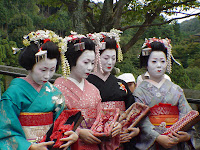 Until the Japanese suffered crushing defeat at the hands of the US in World War II, Japanese religion focused around the figure of the Emperor, a living God, whose subjects saw themselves as part of a huge family of which all Japanese people were members. Alongside this State Shinto, were a varied assortment of different Shinto and Buddhist sects, all combining to form a spiritual framework for the Japanese. Shinto was the religion of life, of living spirits (kami), who affected everyday living; Buddhism, on the other hand, was a religion of death, focusing on one's ancestors and the life to come. These beliefs were supported through a calendar of ritual and an intricate web of social custom.
Until the Japanese suffered crushing defeat at the hands of the US in World War II, Japanese religion focused around the figure of the Emperor, a living God, whose subjects saw themselves as part of a huge family of which all Japanese people were members. Alongside this State Shinto, were a varied assortment of different Shinto and Buddhist sects, all combining to form a spiritual framework for the Japanese. Shinto was the religion of life, of living spirits (kami), who affected everyday living; Buddhism, on the other hand, was a religion of death, focusing on one's ancestors and the life to come. These beliefs were supported through a calendar of ritual and an intricate web of social custom.
The defeat in war, however, shattered many people's beliefs, as the frail voice of the Emperor was broadcast to the nation renouncing his deity. The period since has seen a secularisation of Japanese society almost as dramatic as the economic miracle which saw Japan's post-war economy go into overdrive.
However, much of the ritual has survived the collapse of religious belief. Japanese religion has become, for the vast majority of Japanese, a thing of action, behaviour which defines more their Japanese identity than any spirituality and something which at periodic times of festival, helps strengthen family and community ties.
There are, of course, exceptions to this. The spiritual vacuum left by the Emperor's renunciation was rapidly filled by a plethora of new religions (shin shukyo) which, with their rights enshrined in article 20 of the new constitution, sprang up across Japan.
Mainly concentrated in urban areas, these religions offered this-wordly benefits such as good health, wealth, and good fortune. Many had charismatic Christ-like leaders who inspired a fanatical devotion in their followers. It is here that the roots of such famous 'cults' as the 'Aum cult of the divine truth', who perpetrated the Tokyo subway gas attack of 1996, can be found.
However, the vast majority of new religions are focused on peace and the attainment of happiness, although many Japanese who have no involvement appear suspicious of such organisations. Tax dodging or money laundering are, according to some, par for the course.
Some of the new religions such as PL Kyoden (Public Liberty Kyoden) and Soka Gakkai have, however, become very much a part of the establishment in Japan, and it seems their role in politics and business is not to be underestimated.
For those who have an interest in Buddhism or Shinto, Japan is full of fascinating places to visit. Nara, in the Kansai region near Osaka, is thought to be the original home of Buddhism in Japan and features an extensive museum of Buddhist art and artifacts, as well as the huge statue of Buddha that is Nara's central visitor attraction.
Kyoto is full of beautiful shrines and temples and can provide a unique look back through history to a time when religious belief was a more significant part of everyday life, as well as being simply stunning to behold. In fact, everywhere you go in Japan, you will see the face of the country's religious heritage.
Readmore »»
 2h 40 min from Shinjuku (Tokyo) to Matsumoto Station by JR Chuo Line (limited express), and 1h from Matsumoto to Hakuba Station by JR Oito Line (limited express). 30 min from Matsumoto to Hotaka Station (Azumino) by JR Oito Line
2h 40 min from Shinjuku (Tokyo) to Matsumoto Station by JR Chuo Line (limited express), and 1h from Matsumoto to Hakuba Station by JR Oito Line (limited express). 30 min from Matsumoto to Hotaka Station (Azumino) by JR Oito Line
















